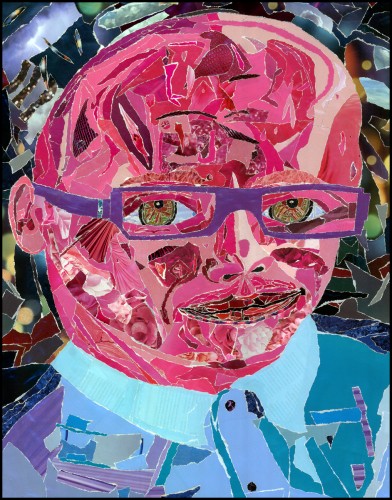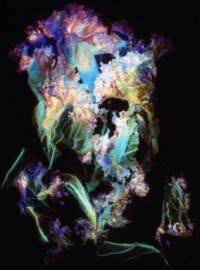Artists have forever captured emotion and experience in manners words cannot convey.
Think: “The Scream” by Norwegian painter Edvard Munch, or “Starry Night” by Vincent van Gogh. Words do neither paintings justice – they must be seen to be “heard.”
Art major, poet and veteran student Kenneth James is such an artist.
Although his military service affected him physically and emotionally, it was the trauma that stemmed from his childhood that impacted him so deeply he prefers not to speak about it in public.
“I told some people and they got so devastated, they didn’t know what to do or say,” James said.
Yet, one only has to study for a few seconds James’s self-portrait, “Portraiture of Passion,” before being swept up into the complexity and intensity of the life experiences that permeate its subject.
“My face is [depicted] in pink because it symbolizes passion – and I love the hue,” he said.
The portrait’s rosy face wears purple thick-rimmed eyeglasses, very similar to the black pair James wears daily. Behind the lenses peer impossibly complex eyes, the irises constructed from countless green, blue and brown bits of paper. James has been told the eyes appear as it they are watching or looking back at the viewer.
“People say the piece resonates like a soul, like there’s somebody alive in there,” James said.
The portrait was generated through a process James calls RIP art. Rip because the images are created though the tearing, layering and composition of thousands of pieces of color paper and magazine images, but also R.I.P., as in Rest In Peace.

Photo credit: Louis C. Cheung
“[I use] Rest in Peace because it [feels] as if my soul has been murdered by trauma,” James said, “[but] I still walk here as a ghost, hoping that someday I can live again.”
Art professor Sue Brown is very familiar with James and his artwork.
“I am drawn to [James's] work because of its intense and varied color,” Brown said. “His ‘RIP art’ is demanding in complexity and surprising in subject matter.”
“I am impressed with his unwavering commitment to his work,” she added.
James is a prolific artist. In addition to his RIP art, he paints, makes sculptures and writes poetry. He presented several art pieces to a PCC audience of roughly 30 people in April.
The event was sponsored by PCC’s poetry club, “Lotus,” and hosted by the club’s co-presidents, Rhianna McGaughey and Gloria Gonzalez in Building C. Gonzalez said the club had recently begun expanding its appreciation to all forms of art.
James called the engagement “Love Triumphant.” In addition to discussing his visual art, he read his poem, “There Is Another Give,” about homelessness.
Veteran student Samantha Sandoval, 22, said she loves James’s poetry because it’s uniquely honest and emotional.
“His artwork affects his poetry. [It's like the two media] bounce off each other – they’re interconnected,” she said.
James said he held the event to educate the audience about trauma, depression and homelessness.
“These are subjects people find difficult to talk about,” he said.
For example, James said, because his physical and emotional disabilities aren’t visually apparent, people often don’t believe they exist and say things like, “You look perfectly fine to me.”
Primarily, he said, only his fellow veteran students are able to truly acknowledge his trauma.
“[Currently,] I’m trying to be successful, write a book, go to school,” James said. “I have a fantasy that a very wealthy benefactor will put me up in a place for a few years and I’ll have the freedom to [write my book and make more art].
“So, yeah, I have lofty dreams, but I believe they may help me [move forward,]” he said.
“I want to be an advocate of truth and justice,” James said. “I have a love for civility and [hope to help] people reach the highest heights of civility through love and education.
This article was originally published in the PCC Courier.






